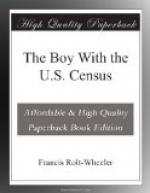“How about the revenue men?” asked Hamilton.
“They haven’t be’n here sence Teacheh went away,” was the reply. “An’ I reckon they’re not wanted.”
The boy stopped short as the old mountaineer came over to where he was squatting and gave him a long answer to the message he had brought. The old man read it to him from a sheet of paper on which he had penciled it roughly. Bill Wilsh listened in a dreamy way, and Hamilton wondered at his seeming carelessness. The old man read it twice, then, rising to his feet, the boy repeated it word for word and without so much as a nod to Hamilton, slouched off in a long, lazy stride that looked like loafing, but which, as Hamilton afterwards found out, covered the ground rapidly.
“Do you suppose he’ll remember all that, Uncle Eli?” asked Hamilton in surprise.
“He? Oh, yes,” the mountaineer replied, “word for word, syllable for syllable—that is, fo’ to-day.”
“He must have a good memory,” the boy exclaimed “I’m sure I couldn’t.”
“But he’ll forget every word by to-morrow,” the other continued, “almost forget that he was hyeh to-day at all. That’s why they’re so hard to teach, those po’ whites, what they learn doesn’t stick. I heard him tellin’ yo’ about the disappearance o’ the last teacheh.”
“Yes, he was putting it down to ‘cunjering.’ Is there much of that sort of idea in the mountains?”
“None among the mount’neers proper,” replied the old man. “Some o’ the po’ whites down in the gullies talk about it, but thar’s mo’ difference between the folks in the gullies an’ on the Ridge th’n there is between the mount’ns an’ the Blue Grass. They are different, an’ they look different, too.”
“Bill Wilsh certainly does,” agreed Hamilton, “but I thought at first it was because he was tired out with a long walk after a day’s work.”
The Kentuckian shook his head.
“They’re all that way,” he said. “They jes’ look all beaten out as if they hadn’t any life left in them at all. I reckon the most o’ them have hookworm, too, an’ they just look fit to drop.”
“Hookworm, Uncle Eli? What is that?” asked the boy.
“It’s a queer kind o’ disease,” the old man answered, “that comes from goin’ barefoot. There’s a kind o’ grub in the soil, and it works its way in. It’s only jes’ recently that it’s be’n found out that the po’ whites are peaked and backward because they’re sick, and now they know a cure fo’ it, why hookworm is being driven right out o’ the South.”
“Was there so much of it?”
“Puttin’ an end to it will make useful American citizens out o’ thousands o’ poor critters that never knew what ailed them.”
“But where did the ‘poor whites’ come from, Uncle Eli? What made them that way?”
“Whar they come from I jes’ don’ rightly know. I reckon I saw more o’ them when I was down in Georgia, but the Florida ‘crackers’ are still worse off. Thar’s not so many in the mount’ns an’ those that are here live ’way up in the gullies. The sure ‘nough po’ whites, or ‘Crackers’ as they call them, belong to the pine belt, between the mount’ns an’ the swamps o’ the coast.”




